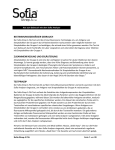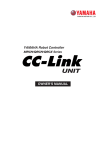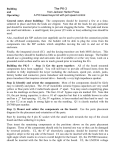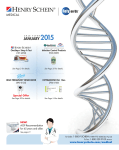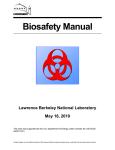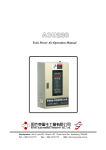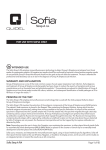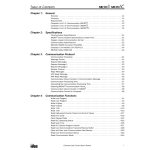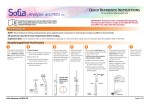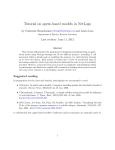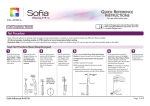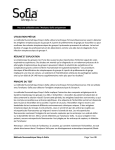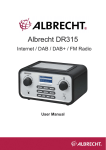Download Package Insert EN
Transcript
For use with the Sofia Analyzer only CLIA Complexity: MODERATE INTENDED USE The Sofia Influenza A+B FIA employs immunofluorescence to detect influenza A and influenza B viral nucleoprotein antigens in nasal swab, nasopharyngeal swab, and nasopharyngeal aspirate/wash specimens taken directly from symptomatic patients. This qualitative test is intended for use as an aid in the rapid differential diagnosis of acute influenza A and influenza B viral infections. The test is not intended to detect influenza C antigens. A negative test is presumptive and it is recommended these results be confirmed by virus culture or an FDA-cleared influenza A and B molecular assay. Negative results do not preclude influenza virus infections and should not be used as the sole basis for treatment or other management decisions. The test is intended for professional and laboratory use. Performance characteristics for influenza A and B were established during February through March 2011 when influenza viruses A/California/7/2009 (2009 H1N1), A/Perth/16/2009 (H3N2), and B/Brisbane/60/2008 (Victoria-Like) were the predominant influenza viruses in circulation according to the Morbidity and Mortality Weekly Report from the CDC entitled “Update: Influenza Activity—United States, 2010–2011 Season, and Composition of the 2011–2012 Influenza Vaccine”. Performance characteristics may vary against other emerging influenza viruses. If infection with a novel influenza virus is suspected based on current clinical and epidemiological screening criteria recommended by public health authorities, specimens should be collected with appropriate infection control precautions for novel virulent influenza viruses and sent to state or local health department for testing. Virus culture should not be attempted in these cases unless a BSL 3+ facility is available to receive and culture specimens. SUMMARY AND EXPLANATION Influenza viruses are causative agents of highly contagious, acute, viral infections of the respiratory tract. Influenza viruses are immunologically diverse, single-stranded RNA viruses. There are three types of influenza viruses: A, B, and C. Type A viruses are the most prevalent and are associated with most serious epidemics. Type B viruses produce a disease that is generally milder than that caused by type A. Type C viruses have never been associated with a large epidemic of human disease. Both Type A and B viruses can circulate simultaneously, but usually one type is dominant during a given season.1 Every year in the United States, on average 5% to 20% of the population contract influenza; more than 200,000 people are hospitalized from influenza complications; and, about 36,000 people die from influenza-related causes. Some people, such as adults 65 years of age and older, young children, and people with certain health conditions, are at high risk for serious influenza complications.2 Sofia Influenza A+B FIA Page 1 of 20 PRINCIPLE OF THE TEST The Sofia Influenza A+B FIA employs immunofluorescence technology that is used with the Sofia Analyzer to detect influenza virus nucleoproteins. This test allows for the differential detection of influenza A and influenza B antigens. The Sofia Influenza A+B FIA involves the disruption of influenza A and B viral antigens. The patient specimen is placed in the Reagent Tube, during which time the virus particles in the specimen are disrupted, exposing internal viral nucleoproteins. After disruption, the specimen is dispensed into the Cassette sample well. From the sample well, the specimen migrates through a test strip containing various unique chemical environments. If influenza viral antigen is present, they will be trapped in a specific location. Note: Depending upon the user’s choice, the cassette is either placed inside of the Sofia Analyzer for automatically timed development (Walk Away Mode) or placed on the counter or bench top for a manually timed development and then placed into the Sofia Analyzer to be scanned (Read Now Mode). The Sofia Analyzer will scan the test strip and measure the fluorescent signal by processing the results using method-specific algorithms. The Sofia Analyzer will display the test results (Positive, Negative, or Invalid) on the screen. The results can also be automatically printed on an integrated printer if this option is selected. REAGENTS AND MATERIALS SUPPLIED 25-Test Kit: n Individually Packaged Cassettes (25): Mouse monoclonal anti-influenza A and anti-influenza B antibodies n Reagent Tubes (25): Lyophilized buffer with detergents and reducing agents n Reagent Solution (25): Ampoules with salt solution n Sterile Nasal Swabs (25) n Fixed Volume Pipettes (25) n Influenza A and Influenza B Positive Control Swab (1): Swab is coated with non-infectious recombinant influenza A and influenza B antigens n Negative Control Swab (1): Swab is coated with heat-inactivated, non-infectious Streptococcus C antigen n Package Insert (1) n Quick Reference Instructions (1) n QC Card (located on kit box) n Printer Paper (1) MATERIALS NOT SUPPLIED IN KIT n Timer or watch n Sofia Analyzer instrument n Micropipettor n Specimen container n Sterile saline n Equipment used for collection of Nasopharyngeal Aspirate or Nasopharyngeal Wash n Nylon flocked nasopharyngeal swab n Calibration Cassette (supplied with the Sofia Analyzer) Sofia Influenza A+B FIA Page 2 of 20 WARNINGS AND PRECAUTIONS n For in vitro diagnostic use. n Do not use the kit contents beyond the expiration date printed on the outside of the box. n Use appropriate precautions in the collection, handling, storage, and disposal of patient samples and used kit contents.3 n Use of Nitrile, Latex (or equivalent) gloves is recommended when handling patient samples.3 n Dispose of containers and used contents in accordance with Federal, State and Local requirements. n Do not reuse the used cassette, fixed volume pipettes, reagent tubes, solutions, or control swabs. n The user should never open the foil pouch of the test Cassette exposing it to the ambient environment until the Cassette is ready for immediate use. n Discard and do not use any damaged cassette or material. n The Reagent Solution contains a salt solution (saline). If the solution contacts the skin or eye, flush with copious amounts of water. n To obtain accurate results, the Package Insert instructions must be followed. n The Calibration Cassette must be kept in the provided storage pouch between uses. n Inadequate or inappropriate specimen collection, storage, and transport may yield false test results. n Specimen collection and handling procedures require specific training and guidance. n Use the Viral Transport Media recommended in this Package Insert. n When collecting a nasal swab specimen, use the nasal swab supplied in the kit. n When collecting a nasopharyngeal swab specimen, use a nylon flocked nasopharyngeal swab. n Do not write on the barcode of the Cassette. This is used by the Sofia Analyzer to identify the type of test being run and to identify the individual Cassette so as to prevent a second read of the Cassette by the same Sofia Analyzer. n If infection with a novel influenza A virus is suspected, based on current clinical and epidemiological screening criteria recommended by public health authorities, specimens should be collected with appropriate infection control precautions for novel virulent influenza viruses and sent to state or local health departments for testing. Viral culture should not be attempted in these cases unless a BSL 3+ facility is available to receive and culture specimens. n Although this test has been shown to detect cultured avian influenza viruses, including avian Influenza A subtype H5N1 virus, the performance characteristics of this test with specimens from humans infected with H5N1 or other avian influenza viruses are unknown. n As the detection reagent is a fluorescent compound, no visible results will form on the test strip. The Sofia Analyzer must be used for result interpretation. KIT STORAGE AND STABILITY Store the kit at room temperature, 59–86°F (15–30°C), out of direct sunlight. Kit contents are stable until the expiration date printed on the outer box. Do not freeze. Sofia Influenza A+B FIA Page 3 of 20 QUALITY CONTROL There are three types of Quality Control for the Sofia Analyzer and Cassette: Sofia Analyzer calibration procedure, built-in procedural control features, and External Controls. Sofia Analyzer Calibration Check Procedure Note: This is a “Calibration Check” procedure. The Calibration Check Procedure should be performed every thirty (30) days. The Sofia Analyzer can be set to remind the user to complete the calibration check procedure. The Calibration Check is a required function that checks the Sofia Analyzer optics and calculation systems using a specific Calibration Cassette. This Calibration Cassette is shipped with the Sofia Analyzer. Refer to the Sofia Analyzer User Manual for details regarding the Calibration Check Procedure. Important: Ensure that the Calibration Cassette is stored in the provided storage pouch between uses to protect from exposure to light. 1. To check the calibration of the Sofia Analyzer, select “Calibration” from the Main Menu. 2. Following the prompts, insert the Calibration Cassette into the Sofia Analyzer and close the drawer. The Analyzer performs the calibration check automatically with no user input required. The Sofia Analyzer indicates when the Calibration Check is completed. Select OK to return to the Main Menu. NOTE: If calibration cannot be completed successfully, notify the on-site Supervisor or contact Quidel Technical Support for assistance from 7:00 a.m.-5:00 p.m. PST at (800) 874-1517 (within the USA); (858) 552-1100 (outside the USA); Fax: (858) 455-4960; [email protected] (Customer Service); [email protected] (Technical Support) or contact your local distributor. Sofia Influenza A+B FIA Page 4 of 20 Built-in Procedural Control The Sofia Influenza A+B FIA contains a built-in procedural control feature. Each time a test is run in the Sofia Analyzer, the procedural control zone is scanned by the Sofia Analyzer and the result is displayed on the Analyzer screen. The manufacturer's recommendation for daily control is to document the results of these built-in procedural controls for the first sample tested each day. This documentation is automatically logged in the Analyzer with each test result. A valid result obtained from the procedural control demonstrates that the test flowed correctly and the functional integrity of the Cassette was maintained. The procedural control is interpreted by the Sofia Analyzer after the Cassette has developed for fifteen (15) minutes. If the test does not flow correctly, the Sofia Analyzer will indicate that the result is invalid. Should this occur, review the procedure and repeat the test with a new patient sample and a new test Cassette. For example: This result shows that an invalid result had occurred. External Quality Control External Controls may also be used to demonstrate that the reagents and assay procedure perform properly. Quidel recommends that Positive and Negative External Controls be run once for each untrained operator, once for each new shipment of kits – provided that each different lot received in the shipment is tested – and as deemed additionally necessary by your internal quality control procedures, and in accordance with local, state and federal regulations or accreditation requirements. The user must first select Run QC on the main Menu of the Sofia Analyzer and then, when prompted, scan the QC Card (located on kit box). This card provides information specific to the kit lot, including lot number and expiration date. The Analyzer will then prompt the user to run the External Control swabs. External Positive and Negative Control swabs are supplied in the kit and should be tested using the Swab Test Procedure provided in this Package Insert or in the Quick Reference Instructions. Note: the Influenza Positive Control Swab should give a positive result for both influenza A and influenza B. Do not perform patient tests or report patient test results if the control tests do not produce the expected results. Repeat the test or contact Quidel Technical Support before testing patient specimens. Additional External Control swabs may be obtained separately by contacting Quidel’s Customer Support Services at (800) 874.1517 (toll-free in the U.S.A.) or (858) 552.1100. SPECIMEN COLLECTION AND HANDLING SPECIMEN COLLECTION Nasal Swab Sample Use the nasal swab supplied in the kit. To collect a nasal swab sample, carefully insert the swab (provided in the kit) into the nostril that presents the most secretion under visual inspection. Using gentle rotation, push the swab until resistance is met at the level of the turbinates (less than one inch into the nostril). Rotate the swab several times against the nasal wall, then remove it from the nostril. Nasopharyngeal Swab Sample Use a nylon flocked nasopharyngeal swab, not supplied. To collect a nasopharyngeal swab sample, carefully insert the swab into the nostril that presents the most secretion under visual inspection. Keep the swab near the septum floor of the nose while gently pushing the swab into the posterior nasopharynx. Rotate the swab several times, then remove it from the nasopharynx. Nasopharyngeal Aspirate/Wash Sample Follow your institution’s protocol for obtaining nasopharyngeal aspirate/wash specimens. Use the minimal amount of saline that your procedure allows. Alternatively, if your institution does not provide a protocol, then consider the following procedures that are used by clinicians: Sofia Influenza A+B FIA Page 5 of 20 To collect a nasopharyngeal aspirate sample: instill a few drops of sterile saline into the nostril to be suctioned. Insert the flexible plastic tubing along the nostril floor, parallel to the palate. After entering the nasopharynx, aspirate the secretions while removing the tubing. The procedure should be repeated for the other nostril if inadequate secretions were obtained from the first nostril. To collect a nasopharyngeal wash sample: a child could sit in the parent’s lap facing forward, with the child’s head against the parent’s chest. Fill the syringe or aspiration bulb with the minimal volume of saline required per the subject’s size and age. Instill the saline into one nostril while the head is tilted back. Aspirate the wash specimen back into the syringe or bulb. The aspirated wash sample will likely be approximately 1 cc in volume. Alternatively, following instillation of the saline, tilt the head forward and let the saline drain out into a clean collection cup. SPECIMEN TRANSPORT AND STORAGE Specimens should be tested as soon as possible after collection. However, if transport of samples is required, minimal dilution of the sample is recommended, as dilution may result in decreased test sensitivity. One (1) milliliter or less is suggested for optimal rapid test performance. The following viral transport media listed in Table 1 are compatible with the Sofia Influenza A+B FIA: Table 1 Recommended Viral Transport Media Recommended Storage Condition Viral Transport Media 2–8°C 25°C Copan Universal Transport Media 72 hours 72 hours Hank’s Balanced Salt Solution 24 hours Not recommended M4 72 hours 72 hours M4-RT 72 hours 72 hours M5 72 hours 72 hours M6 72 hours 72 hours Modified Liquid Stuarts 6 hours Not recommended Saline 24 hours 4 hours Starplex Multitrans 72 hours 72 hours TEST PROCEDURES All clinical specimens must be at room temperature before beginning the assay. Expiration date: Check expiration on each individual test package or outer box before using. Do not use any test past the expiration date on the label. Swab Test Procedure (Nasal / Nasopharyngeal Swab) 1. Add the Reagent Solution to the Reagent Tube. Gently swirl the Reagent Tube to dissolve its contents. Reagent Solution Reagent Tube Sofia Influenza A+B FIA Page 6 of 20 2. Immediately place the patient swab sample into the Reagent Tube. Roll the swab a minimum of three (3) times while pressing the head against the bottom and side of the Reagent Tube. Leave the swab in the Reagent Tube for one (1) minute. 3x 1 3. Express all liquid from the swab head by rolling it against the inside of the Reagent Tube as the swab is being removed. Discard the swab in accordance with your biohazard waste disposal protocol. 4. Fill the provided fixed volume pipette (120 µL) or a micropipettor with 120 µL of the patient sample from the Reagent Tube. 3x Squeeze here Overflow To fill the fixed volume pipette with the patient sample: a.FIRMLY squeeze the top bulb. Pipette OR b.Still squeezing, place the pipette tip into the liquid sample. c.With the pipette tip still in the liquid sample, release pressure on bulb to fill the pipette. Patient Sample Patient Sample 5. Dispense the patient sample into the Cassette sample well. Firmly squeeze the top bulb to empty the contents of the fixed volume pipette into the Cassette sample well (extra liquid in the overflow bulb is OK). NOTE: The fixed volume pipette is designed to collect and dispense the correct amount of liquid sample. Discard the pipette in accordance with your biohazard waste disposal protocol. OR Sample Well 6. Proceed to the “Using the Sofia Analyzer” section of this Package Insert. Sofia Influenza A+B FIA Page 7 of 20 Nasopharyngeal Aspirate/Wash or Specimens in Viral Transport Media Test Procedure 1. Add the Reagent Solution to the Reagent Tube. Gently swirl the Reagent Tube to dissolve its contents. Reagent Solution Reagent Tube 2. Fill a micropipettor with 260 µL of the patient’s liquid sample. Dispense the contents of the micropipettor into the Reagent Tube. Gently swirl the Reagent Tube to mix its contents. Patient Sample Reagent Tube 3. Fill the provided fixed volume pipette (120 µL) or a micropipettor with 120 µL of the patient sample from the Reagent Tube. Squeeze here Overflow To fill the fixed volume pipette with the patient sample: a.FIRMLY squeeze the top bulb. Pipette OR b.Still squeezing, place the pipette tip into the liquid sample. c.With the pipette tip still in the liquid sample, release pressure on bulb to fill the pipette. Patient Sample Patient Sample 4. Dispense the patient sample into the Cassette sample well. Firmly squeeze the top bulb to empty the contents of the fixed volume pipette into the Cassette sample well (extra liquid in the overflow bulb is OK). NOTE: The fixed volume pipette is designed to collect and dispense the correct amount of liquid sample. Discard the pipette in accordance with your biohazard waste disposal protocol. OR 5. Proceed to the “Using the Sofia Analyzer” section of this Package Insert. Sample Well Sofia Influenza A+B FIA Page 8 of 20 USING THE SOFIA ANALYZER Walk Away / Read Now Modes Refer to the Sofia Analyzer User Manual for operating instructions. The Sofia Analyzer may be set to two different development timed modes (Walk Away and Read Now). The procedures for each mode are described below. Walk Away Mode Using the barcode reader, scan in the user and patient IDs. After the user adds the patient sample and inserts the Cassette into the Sofia Analyzer, the Analyzer will automatically time the test development, scan, and display the test result in about fifteen (15) minutes. Read Now Mode The Read Now mode provides a convenient way for busy laboratories to conduct batch testing. The user adds the patient sample to the Cassette and places the Cassette on the counter or bench top for fifteen (15) minutes (outside of the Analyzer). The user must carefully and manually time the development step. When the development time is approaching completion, enter user ID and patient ID with the provided barcode reader. Once the development time is complete, the user immediately inserts the Cassette into the Sofia Analyzer. The Analyzer will scan and display the test result within one (1) minute. Note: Results will remain stable for an additional fifteen (15) minutes after the recommended development time of fifteen (15) minutes. Depending upon the workload, several options exist to make batch testing easier. The user can add the Reagent Solution to one or more Reagent Tubes, recap them, and store them on the bench at RT for up to 12 hours without loss of activity before adding the sample(s). Alternatively, after addition of the Reagent Solution, the user can process the swab or liquid specimens in the Reagent Tube, then after removing the swab, recap the tube and let them stand at RT for up to 12 hours without loss of activity before testing. Critically important, the user should never open the foil pouch thus exposing the test Cassette to the ambient environment, until they are ready for immediate use. Run Test When placing the Cassette into the Sofia Analyzer, the user ID, patient ID, and order # can be entered via a handheld barcode scanner or by manually entering the information onto the keypad of the Sofia Analyzer. The test ID (test type, lot #, Cassette serial #, and test expiration date) on the Cassette is scanned automatically into the Sofia Analyzer with an internal barcode reader. The test is automatically interpreted at fifteen (15) minutes when the Analyzer is set to the Walk Away Mode and will give the result within one (1) minute after inserting the Cassette when the Analyzer is set to the Read Now Mode. NOTE: If you mistakenly scan the incorrect barcode, simply rescan using the correct barcode, and the previous one will be overwritten with the correct barcode. 1. Highlight User ID field using the Arrow Buttons on the Sofia Analyzer key pad. Input the user ID using the barcode scanner or manually enter the data using the key pad. Sofia Influenza A+B FIA Page 9 of 20 2. Press the Down Arrow on the Sofia Analyzer keypad to go to the Patient ID or Order # field. Input patient ID or Order # using the barcode scanner or manually enter the data using the key pad. 3. Press Start Test and the Sofia Analyzer drawer will automatically open. 4. Verify that the correct development mode, Walk Away or Read Now, has been selected. Immediately insert the prepared patient test Cassette into the drawer of the Sofia Analyzer and close the drawer. 5. Upon closing the drawer, the Sofia Analyzer will start automatically and display the progress as shown in example below. In the Walk Away Mode, the test results will be displayed on the screen in approximately fifteen (15) minutes after the Cassette is inserted into the Sofia Analyzer. In the Read Now Mode, the test results will be displayed on the screen within one (1) minute after the Cassette is inserted into the Analyzer. See Interpretation of Results section. For example: This display shows that the test in Walk Away mode has 12 minutes, 13 seconds remaining. The Sofia Analyzer will read and display the results after 15 minutes. Sofia Influenza A+B FIA Page 10 of 20 INTERPRETATION OF RESULTS When the test is complete, the results will be displayed on the Sofia Analyzer screen. The results can be automatically printed on the integrated printer if this option is selected. The Sofia Analyzer detects the test line. The test line will not be visible to the user. The Sofia Analyzer screen will display results for the procedural control as being “valid or invalid,” and will individually provide a positive or negative result for both influenza A and influenza B. If the procedural control is “invalid,” retest with a new patient sample and a new Cassette. Positive Results: For example: This result shows that a valid result had occurred and that the specimen was positive for Influenza A. NOTE: A positive result does not rule out co-infections with other pathogens or identify any specific influenza A virus subtype. For example: This result shows that a valid result had occurred and that the specimen was positive for Influenza B. NOTE: A positive result does not rule out co-infections with other pathogens. For example: This result shows that a valid result had occurred and that the specimen was positive for both Influenza A and Influenza B. NOTE: A positive result does not rule out co-infections with other pathogens. NOTE: Co-infection with influenza A and B is rare. Sofia Influenza A+B FIA “dual positive” clinical specimens (influenza A and influenza B positive) should be re-tested. Repeatable influenza A and B “dual positive” results should be confirmed by virus culture or an FDA-cleared influenza A and B molecular assay before reporting results. Sofia Influenza A+B FIA Page 11 of 20 Negative Results: For example: This result shows that a valid result had occurred and that the specimen was negative for Influenza A and Influenza B. NOTE: A negative result does not exclude influenza viral infection. Negative results should be confirmed by virus culture or an FDA-cleared influenza A and B molecular assay. Invalid Results: For example: This result shows that an invalid result had occurred. Invalid Result: If the test is invalid, a new test should be performed with a new patient sample and a new test Cassette. LIMITATIONS n The contents of this kit are to be used for the qualitative detection of influenza type A and B antigens from a nasal swab, nasopharyngeal swab, and nasopharyngeal aspirate/wash specimens. n This test detects both viable (live) and non-viable influenza A and B. Test performance depends on the amount of virus (antigen) in the specimen and may or may not correlate with virus culture results performed on the same specimen. n The clinical performance of the Sofia Influenza A+B FIA for nasopharyngeal aspirate/wash samples has not been established in patients 60 years of age and older and may not be consistent with the clinical performance obtained with younger patients. n A negative test result may occur if the level of antigen in a sample is below the detection limit of the test or if the sample was collected or transported improperly. n Failure to follow the Test Procedure may adversely affect test performance and/or invalidate the test result. n Test results must be evaluated in conjunction with other clinical data available to the physician. n Positive test results do not rule out co-infections with other pathogens. n Positive test results do not identify specific influenza A virus subtypes. n Negative test results are not intended to rule in other non-influenza viral or bacterial infections. n Children tend to shed virus more abundantly and for longer periods of time than adults. Therefore, testing specimens from adults will often yield lower sensitivity than testing specimens from children. n Positive and negative predictive values are highly dependent on prevalence. False negative test results are more likely during peak activity when prevalence of disease is high. False positive test results are more likely during periods of low influenza or activity when prevalence is moderate to low. n Individuals who received nasally administered influenza A vaccine may have positive test results for up to three days after vaccination. n Monoclonal antibodies may fail to detect, or detect with less sensitivity, influenza A viruses that have undergone minor amino acid changes in the target epitope region. Sofia Influenza A+B FIA Page 12 of 20 n If differentiation of specific influenza A subtypes and strains is needed, additional testing, in consultation with state or local public health departments, is required. n Samples contaminated with whole blood >4% v/v or mucin >0.5% v/v may interfere in the interpretation of the test. Visually bloody or overly viscous samples should not be used. n The performance of this test has not been evaluated for use in patients without signs and symptoms of respiratory infection. EXPECTED VALUES Seasonal outbreaks of influenza occur worldwide in both the northern and southern hemispheres causing widespread illness each winter. The average attack rate of influenza is 26–33 cases per 100 people per year. The risk of hospitalization is roughly 1/300 of those infected among the very young and elderly. Over a period of 30 years, between 1976 and 2006, estimates of flu-associated deaths in the United States ranged from a low of about 3,000 to a high of about 49,000 people.2 Ninety percent (90%) of deaths occur in those 65 years of age and older.4 Influenza pandemics occurred in 1918, 1957, 1968 and 2009. In the 1918 pandemic, an estimated 40–50 million deaths resulted worldwide. The prevalence observed with the reference test (virus culture) during the 2011 clinical study for Sofia Influenza A+B FIA was 15% for influenza A and 13% for influenza B. PERFORMANCE CHARACTERISTICS Sofia Influenza A+B FIA Performance vs. Cell Culture The performance of the Sofia Influenza A+B FIA was compared to viral cell culture methods followed by DFA in a multi-center clinical field study during February through March 2011 in the United States. This study was conducted by health care personnel at seventeen (17) distinct sites in various geographical regions within the United States. In this multi-center, point-of-care (POC) field trial, two (2) nasal or two (2) nasopharyngeal swabs or nasopharyngeal aspirate/wash specimens were collected from each of two thousand forty-seven (2047) patients. Six hundred sixty-five (665) provided a nasal swab specimen, seven hundred thirty-three (733) provided a nasopharyngeal swab specimen and six hundred forty-nine (649) provided a nasopharyngeal aspirate/wash specimen. All clinical samples were collected from symptomatic patients. Seventy-one percent (71%) of the population tested were <6 years of age, 22% 6–21 years of age, 6% 22–59 years of age, and 1% ≥60 years of age. Fifty-three percent (53%) were male and forty-seven percent (47%) were female. On-site testing of one nasal swab or nasopharyngeal swab or a portion of nasopharyngeal aspirate/wash specimen in the Sofia Influenza A+B FIA test was performed on the fresh specimen by medical personnel in the physician’s office or hospital facility. The remaining sample was placed in viral transport media. The paired swab samples were randomized with respect to the order of testing in the Sofia Influenza A+B FIA versus culture. Cell culture was performed either at a local virus laboratory of the test site or transported cold on ice packs, not frozen, overnight to a central laboratory for culture within 48 hours. Results are presented in Tables 2–6. Table 2 Sofia Influenza A+B FIA Nasal Swab Results Versus Culture (All Age Groups) TYPE A TYPE B Culture Sens = 124/138 = 90% (95% C.I. 84–94%) Pos Neg Sofia Pos 124 27 Spec = 500/527 = 95% (95% C.I. 93–96%) Sofia Neg 14 500 Culture Sens = 100/112 = 89% (95% C.I. 82–94%) Pos Neg Sofia Pos 100 23 Spec = 530/553 = 96% (95% C.I. 94–97%) Sofia Neg 12 530 Table 3 Sofia Influenza A+B FIA Nasopharyngeal Swab Results Versus Culture (All Age Groups) TYPE A TYPE B Culture Sens = 100/103 = 97% (95% C.I. 91–99%) Pos Neg Sofia Pos 100 34 Spec = 596/630 = 95% (95% C.I. 93–96%) Sofia Neg 3 596 Sofia Influenza A+B FIA Culture Sens = 101/112 = 90% (95% C.I. 83-95%) Pos Neg Sofia Pos 101 19 Spec = 602/621 = 97% (95% C.I. 95-98%) Sofia Neg 11 602 Page 13 of 20 Table 4 Sofia Influenza A+B FIA Nasopharyngeal Aspirate/Wash Results Versus Culture (All Age Groups) TYPE A TYPE B Culture Sens = 68/69 = 99% (95% C.I. 91–100%) Pos Neg Sofia Pos 68 26 Spec = 554/580 = 96% (95% C.I. 93–97%) Sofia Neg 1 554 Culture Sens = 46/52 = 88% (95% C.I. 77–95%) Pos Neg Sofia Pos 46 22 Spec = 575/597 = 96% (95% C.I. 94–98%) Sofia Neg 6 575 Table 5 Performance Compared to Culture for Each Specimen Type by Age Group for Influenza A Nasal Swabs Nasopharyngeal Swabs Nasopharyngeal Aspirate/Wash Sensitivity Specificity Sensitivity Specificity Sensitivity Specificity All Ages 90% (124/138) (95%CI=84-94%) 95% (500/527) (95%CI=93-96%) 97% (100/103) (95%CI=91-99%) 95% (596/630) (95%CI=93-96%) 99% (68/69) (95%CI=91-100%) 96% (554/580) (95%CI=93-97%) <6 years 95% (62/65) (95%CI=87-99%) 95% (210/221) (95%CI=91-97%) 97% (61/63) (95%CI=86-100%) 94% (444/470) (95%CI=92-96%) 99% (68/69) (95%CI=91-100%) 95% (544/570) (95%CI=93-97%) 6 to 21 years 87% (46/53) (95%CI=75-94%) 95% (193/204) (95%CI=91-97%) 97% (35/36) (95%CI=85-100%) 94% (136/144) (95%CI=89-97%) N/A (0/0) 100% (10/10) (95%CI=68-100%) 22 to 59 years 78% (14/18) (95%CI=54-92%) 96% (82/85) (95%CI=90-99%) 100% (4/4) (95%CI=45-100%) 100% (15/15) (95%CI=76-100%) N/A (0/0) N/A (0/0) 60 Years and up 100% (2/2) (95%CI=29-100%) 88% (15/17) (95%CI=64-98%) N/A (0/0) 100% (1/1) (95%CI=17-100%) N/A (0/0) N/A (0/0) Table 6 Performance Compared to Culture for Each Specimen Type by Age Group for Influenza B Nasal Swabs Nasopharyngeal Swabs Nasopharyngeal Aspirate/Wash Sensitivity Specificity Sensitivity Specificity Sensitivity Specificity All Ages 89% (100/112) (95%CI=82-94%) 96% (530/553) (95%CI=94-97%) 90% (101/112) (95%CI=83-95%) 97% (602/621) (95%CI=95-98%) 88% (46/52) (95%CI=77-95%) 96% (575/597) (95%CI=94-98%) <6 years 90% (35/39) (95%CI=76-97%) 96% (238/247) (95%CI=93-98%) 87% (54/62) (95%CI=76-94%) 97% (455/471) (95%CI=95-98%) 87% (39/45) (95%CI=73-94%) 96% (572/594) (95%CI=94-98%) 6 to 21 years 92% (56/61) (95%CI=82-97%) 95% (187/196) (95%CI=91-98%) 94% (45/48) (95%CI=83-98%) 98% (130/132) (95%CI=94-100%) 100% (7/7) (95%CI=60-100%) 100% (3/3) (95%CI=38-100%) 22 to 59 years 73% (8/11) (95%CI=43-91%) 97% (89/92) (95%CI=90-99%) 100% (2/2) (95%CI=29-100%) 94% (16/17) (95%CI=71-100%) N/A (0/0) N/A (0/0) 60 Years and up 100% (1/1) (95%CI=17-100%) 89% (16/18) (95%CI=66-98%) N/A (0/0) 100% (1/1) (95%CI=17-100%) N/A (0/0) N/A (0/0) A total of 2047 prospective clinical specimens were tested and gave valid results during this clinical study. These results were included in Tables 2–6. There were nineteen (19) additional specimens (less than 1% of the total collected) that gave invalid results. The invalid results were excluded from Tables 2–6 because new patient specimens were not collected for re-testing. Sofia Influenza A+B FIA Page 14 of 20 Reproducibility Studies The reproducibility of the Sofia Influenza A+B FIA was evaluated at three different laboratories, one of which was Quidel. Two different operators at each site tested a series of coded, contrived samples, prepared in negative clinical matrix, ranging from low negative to moderate positive influenza A and influenza B. Testing occurred on five (5) different days spanning over approximately a two-week period. The inter-laboratory agreement (Table 7) for negative samples was 94–100% and 98–100% for positive samples. The intra-laboratory agreement (Table 8) for all samples ranged from 98–99%. Table 7 Sofia Influenza A+B Reproducibility Study Inter-Laboratory Agreement Laboratory Site Neg (no virus) Flu A High Neg (C5) Flu A Low Pos (C95) Flu A Mod Pos (C3X) Flu B High Neg (C5) Flu B Low Pos (C95) Flu B Mod Pos (C3X) 1 30/30 29/30 30/30 30/30 28/30 29/30 30/30 2 30/30 29/30 30/30 30/30 30/30 29/30 30/30 3 30/30 30/30 30/30 30/30 27/30 30/30 30/30 Total 90/90 88/90 90/90 90/90 85/90 88/90 90/90 % Overall Agreement with Expected Result (95% CI) 100% (95-100%) 98% (92-100%) 100% (95-100%) 100% (95-100%) 94% (87-98%) 98% (92-100%) 100% (95-100%) Table 8 Sofia Influenza A+B Reproducibility Study Intra-Laboratory Agreement Neg (no virus) Flu A High Neg (C5) 1 30/30 29/30 30/30 30/30 28/30 29/30 30/30 98% (206/210) (95-100%) 2 30/30 29/30 30/30 30/30 30/30 29/30 30/30 99% (208/210) (96-100%) 3 30/30 30/30 30/30 30/30 27/30 30/30 30/30 99% (207/210) (96-100%) Flu A Flu A Low Pos (C95) Mod Pos (C3X) Flu B High Neg (C5) % Overall Agreement with Expected Result (95% CI) Lab. Site Flu B Flu B Low Pos (C95) Mod Pos (C3X) Limit of Detection The limit of detection (LoD) for the Sofia Influenza A+B FIA was determined using a total of four (4) strains of human influenza viruses, two (2) influenza A and two (2) influenza B viruses (Table 9). Table 9 Limit of Detection with Human Isolates of Influenza A and B Viral Strain A/California/07/2009 A/Hong Kong/8/68 B/Allen/45 B/Malaysia/2506/04 Viral Type A A B B Sub-Type 2009 H1N1 H1N1 Minimum Detectable Level (TCID50 /mL) 202 105 40 24 TCID50 /mL levels were determined by either the Reed-Muench method or Rowe ELISA. Sofia Influenza A+B FIA Page 15 of 20 Analytical Reactivity Analytical reactivity was demonstrated using a total of twenty-nine (29) strains of human influenza viruses comprised of twenty (20) Influenza A and nine (9) influenza B viruses (Table 10). Table 10 Analytical Reactivity with Human Isolates of Influenza A and B Viral Viral Strain Type Sub-Type A/Fort Monmouth/1/47 A H1N1 A/New Caledonia/20/1999 A H1N1 A/New Jersey/8/76 A H1N1 A/NWS/33 A H1N1 A/Puerto Rico/8/34 A H1N1 A/Solomon Islands/3/06 A H1N1 A/Taiwan/42/06 A H1N1 A/WI/629-9/2008 A H1N1 A1/Denver/1/57 A H1N1 Influenza/Mexico/4108/2009 A 2009 H1N1 A/WI/629(D02312)/2009 A 2009 H1N1 A/WI/629(D02473)/2009 A 2009 H1N1 A/Port Chalmers/1/73 A H3N2 A/Victoria/3/75 A H3N2 A/WI/629-2/2008 A H3N2 Viral Strain A/Anhui/1/2013* Viral Type Sub-Type A H7N9 Minimum Detectable Level (TCID50/mL) 50 200 500 0.63 100 0.31 200 200 20 200 50 25 500 200 20 Minimum Detectable Level (EID50/mL) 3.95 x 106 Viral Strain A/Wisconsin/67/05 A2/Aichi/2/68 A/Anhui/01/2005 A/GWT/LA/169GW/88 A/Shearwater/Australia 2576/79 B/Brisbane/60/2008 B/Florida/04/2006 B/Florida/07/2004 B/GL/1739/54 B/Hong Kong/5/72 B/Lee/40 B/Maryland/1/59 B/Ohio /1/2005 B/Taiwan/2/62 Minimum Detectable Viral Level Type Sub-Type (TCID50/mL) A H3N2 20 A H3N2 1.25 A H5N1 5 A H10N7 20 A H15N9 10 B B B B B B B B B 10 250 500 1000 20 5 50 50 50 TCID50/mL = 50% tissue culture infectious dose. EID50/mL = 50% egg infective dose. TCID50 and EID50 levels were determined by the Reed-Muench method. *Although this test has been shown to detect H7N9 virus cultured from a positive human respiratory specimen, the performance characteristics of this device with clinical specimens that are positive for H7N9 influenza virus have not been established. The Sofia Influenza A+B FIA can distinguish between influenza A and B viruses, but it cannot differentiate influenza subtypes. Sofia Influenza A+B FIA Page 16 of 20 Table 11 Analytical Reactivity with Different Isolates of Avian Influenza A Viral Strain A/Mallard/NY6750/78 A/Mallard/OH/338/86 A/Mallard/WI/34/75 A/Chicken/CA/431/00 A/Chicken/NJ/15086-3/94 A/Blue Winged Teal/LA/B174/86 A/Chicken/NJ/122210/97 A/Chicken/NJ/15906-9/96 A/Duck/LA/188D/87 A/Gull/MD/704/77 A/Mallard/GurjevRussia/262/82 A/Shorebird/DE/172/2006 Viral Type A A A A A A A A A A A A Minimum Detectable Level Sub-Type (TCID50/mL) H2N2 100 H4N8 50 H5N2 100 H6N2 50 H7N3 5 H8N4 10 H9N2 10 H11N9 50 H12N5 50 H13N6 0.625 H14N5 20 H16N3 2 *The performance characteristics for influenza A virus subtypes emerging as human pathogens have not been established. Sofia Influenza A+B FIA Page 17 of 20 Analytical Specificity Cross Reactivity The Sofia Influenza A+B FIA was evaluated with a total of eighteen (18) bacterial and fungal microorganisms and sixteen (16) non-influenza viral isolates. Bacterial and fungal isolates were evaluated at a concentration of 2x106 cfu/mL. Viral isolates were evaluated at a concentration of 2x105 TCID50/mL. None of the organisms or non-influenza viruses listed below in Table 12 showed any sign of cross reactivity in the assay. Flow of the sample and appearance of the Control Line were also not affected. Table 12 Analytical Specificity and Cross Reactivity Organism/Non-Influenza Virus Bordetella pertussis Canidida albicans Chlamydia trachomatis Corynebacterium diphtheriae Escherichia coli Haemophilus influenzae Lactobacillus plantarum Legionella pneumophila Moraxella catarrhalis Mycobacterium tuberculosis (avirulent) Mycoplasma pneumoniae Neisseria meningitidis Neisseria subflava Pseudomonas aeruginosa Staphylococcus epidermidis Streptococcus pneumoniae Streptococcus pyogenes Streptococcus salivarius Adenovirus type 1 Adenovirus type 7 Human coronavirus (OC43) Human coronavirus (229E) Human coxsackievirus Cytomegalovirus Epstein Barr Virus Human parainfluenza type 1 Human parainfluenza type 2 Human parainfluenza type 3 Measles Human metapneumovirus Mumps virus Respiratory syncytial virus type A Respiratory syncytial virus type B Rhinovirus type 1B Concentration* 2x106 cfu/mL 2x106 cfu/mL 2x106 cfu/mL 2x106 cfu/mL 2x106 cfu/mL 2x106 cfu/mL 2x106 cfu/mL 2x106 cfu/mL 2x106 cfu/mL 2x106 cfu/mL 2x106 cfu/mL 2x106 cfu/mL 2x106 cfu/mL 2x106 cfu/mL 2x106 cfu/mL 2x106 cfu/mL 2x106 cfu/mL 2x106 cfu/mL 2x105 TCID50/mL 2x105 TCID50/mL 2x105 TCID50/mL 2x105 TCID50/mL 2x105 TCID50/mL 2x105 TCID50/mL 2x105 TCID50/mL 2x105 TCID50/mL 2x105 TCID50/mL 2x105 TCID50/mL 2x105 TCID50/mL 2x105 TCID50/mL 2x105 TCID50/mL 2x105 TCID50/mL 2x105 TCID50/mL 2x105 TCID50/mL Flu A Result Negative Negative Negative Negative Negative Negative Negative Negative Negative Negative Negative Negative Negative Negative Negative Negative Negative Negative Negative Negative Negative Negative Negative Negative Negative Negative Negative Negative Negative Negative Negative Negative Negative Negative Flu B Result Negative Negative Negative Negative Negative Negative Negative Negative Negative Negative Negative Negative Negative Negative Negative Negative Negative Negative Negative Negative Negative Negative Negative Negative Negative Negative Negative Negative Negative Negative Negative Negative Negative Negative *The levels of bacteria were determined by limiting dilution, bacterial culture, and colony counting to give cfu/mL. Virus concentrations were determined by standard virology methods, Reed-Muench. Sofia Influenza A+B FIA Page 18 of 20 Interfering Substances Whole blood, mucin, and several over-the-counter (OTC) products and common chemicals were evaluated and did not interfere with the Sofia Influenza A+B FIA at the levels tested (Table 13). Table 13 Non-interfering Substances Substance Whole Blood Mucin Ricola (Menthol) Sucrets (Dyclonin/Menthol) Chloraseptic (Menthol/Benzocaine) Naso GEL (NeilMed) CVS Nasal Drops (Phenylephrine) Afrin (Oxymetazoline) CVS Nasal Spray (Cromolyn) Nasal Gel (Oxymetazoline) Zicam Homeopathic (Alkalol) Fisherman’s Friend Sore Throat Phenol Spray Tobramycin Mupirocin Fluticasone Propionate Tamiflu (Oseltamivir Phosphate) Concentration 4% 0.5% 1.5 mg/mL 1.5 mg/mL 1.5 mg/mL 5% v/v 15% v/v 15% v/v 15% v/v 10% v/v 5% v/v 1:10 dilution 1.5 mg/mL 15% v/v 4 μg/mL 10 mg/mL 5% v/v 5 mg/mL ASSISTANCE If you have any questions regarding the use of this product, please call Quidel’s Technical Support Number (800) 874-1517 (toll-free in the U.S.A.) or (858) 552-1100, Monday through Friday, between 7:00 a.m. and 5:00 p.m., Pacific Time, U.S.A. If outside the United States contact your local distributor or [email protected]. For additional Quick Reference Instructions in your language, please see our website quidel.com, or contact Quidel Technical Support (858) 552-1100 or your local distributor for a copy delivered free of charge. REFERENCES 1. Murphy B.R. and Webster R.G., 1996, Orthomyxoviruses, pp. 1397-1445. In: Fields Virology, 3rd edition, B.N. Fields, D.M. Knipe, P.M. Howley, et al. (eds.), Lippincott-Raven, Philadelphia. 2. CDC, Key Facts About Seasonal Influenza. www.cdc.gov/flu/keyfacts.htm accessed 7/2011. 3. Biosafety in Microbiological and Biomedical Laboratories, 5th Edition. U.S. Department of Health and Human Services, CDC, NIH, Washington, DC (2007). 4. Bartlett J. Management of Respiratory Tract Infections. 2nd Ed, 1999: 149-169. Sofia Influenza A+B FIA Page 19 of 20 20218 – Sofia Influenza A+B FIA – 25 Test 20254 – Sofia Influenza A+B FIA – 25 Test MDSS GmbH Schiffgraben 41 30175 Hannover, Germany Quidel Corporation Worldwide Headquarters 10165 McKellar Court San Diego, CA 92121 USA quidel.com R 1170003EN00 (07/13) Authorized Representative in the European Community Catalogue number Positive control Negative control Batch code For In Vitro diagnostic use Consult instructions for use Use by Manufacturer Temperature limitation Sofia Influenza A+B FIA Page 20 of 20




















